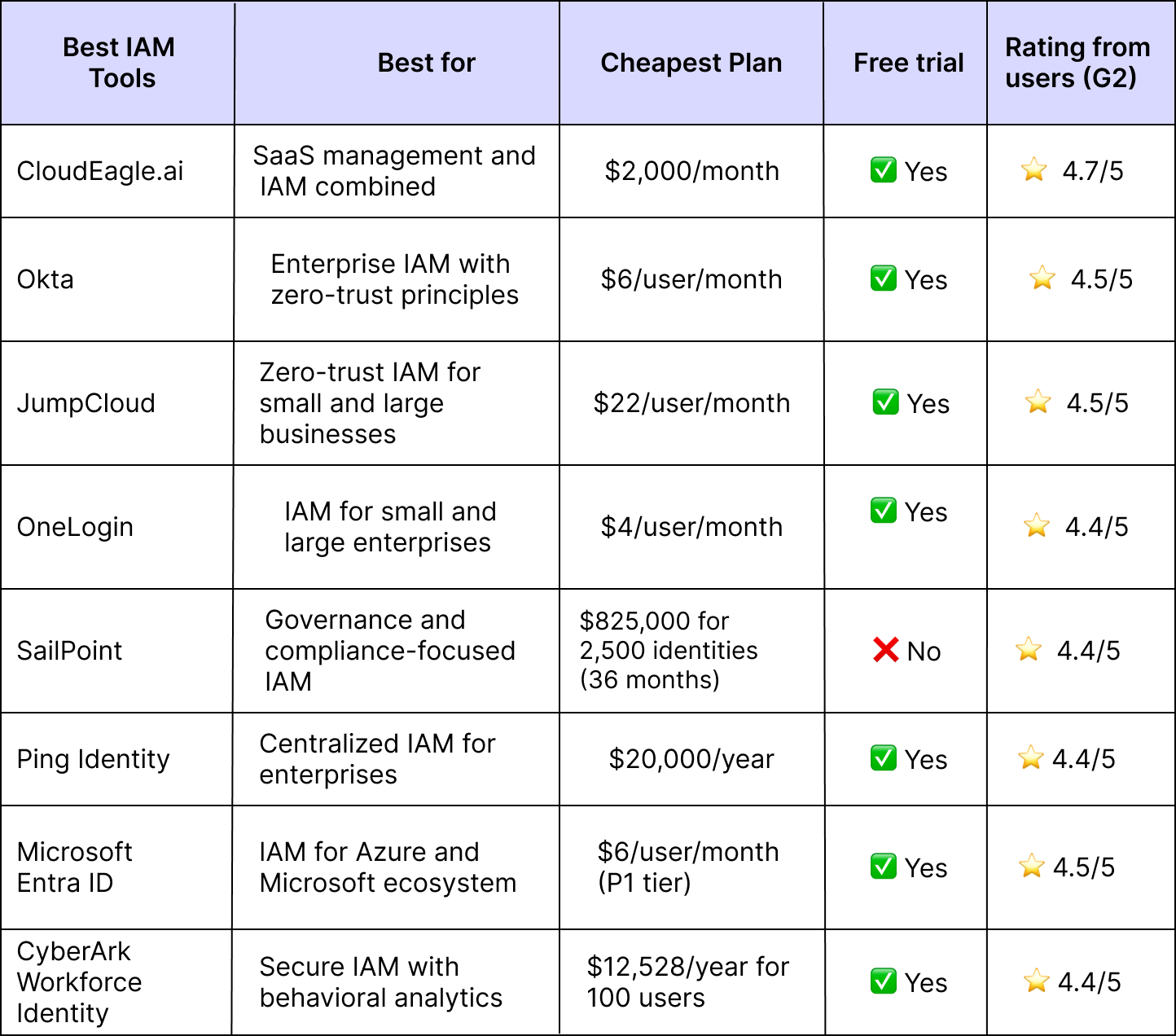Top Identity and Access Management Vendors
Identity and Access Management (IAM) is a critical component of modern cybersecurity strategies, helping organisations secure their digital assets by managing user identities and controlling access to resources. As the demand for IAM solutions continues to grow, several vendors stand out for their innovative technologies and comprehensive offerings. Here are some of the top IAM vendors in the market:
Okta
Okta is a leading IAM vendor known for its cloud-based identity management solutions. With features such as single sign-on, multi-factor authentication, and user provisioning, Okta offers a robust platform that helps organisations streamline access control processes while enhancing security.
Microsoft Azure Active Directory
Microsoft Azure Active Directory is a widely-used IAM solution that integrates seamlessly with Microsoft’s ecosystem of products and services. Offering features like identity governance, conditional access policies, and role-based access control, Azure AD provides organisations with a comprehensive toolset for managing identities and securing access to resources.
IBM Security Identity Governance and Intelligence
IBM Security Identity Governance and Intelligence is a sophisticated IAM solution that focuses on identity governance and compliance management. With capabilities for access certification, policy enforcement, and audit reporting, IBM Security Identity Governance and Intelligence help organisations maintain regulatory compliance while mitigating security risks.
SailPoint
SailPoint is known for its identity governance platform that offers automated provisioning, role management, and access request workflows. By providing visibility into user access rights across the enterprise, SailPoint helps organisations reduce the risk of unauthorised access while improving operational efficiency.
ForgeRock
ForgeRock is an open-source IAM vendor that specialises in customer identity management solutions. With features such as identity orchestration, consent management, and fraud detection capabilities, ForgeRock enables businesses to deliver secure and seamless digital experiences to their customers while maintaining compliance with data privacy regulations.
These are just a few of the top IAM vendors that are shaping the landscape of identity and access management today. Each vendor brings unique strengths to the table, catering to different organisational needs and requirements in an increasingly complex cybersecurity environment.
Top Identity and Access Management Vendors: Answers to Common Questions
- Who offers the best identity management in the industry?
- Which identity access management tool is best?
- What is an IAM vendor?
- What are IAM platforms?
- Who is the top provider of IAM solutions?
- Who is Okta’s biggest competitor?
- Is CyberArk an IAM tool?
- What are the top 5 IAM tools?
Who offers the best identity management in the industry?
When it comes to the question of who offers the best identity management in the industry, it is important to consider that the concept of “best” can vary depending on specific organisational requirements and preferences. Several top identity and access management vendors, such as Okta, Microsoft Azure Active Directory, IBM Security Identity Governance and Intelligence, SailPoint, and ForgeRock, are recognised for their advanced features and capabilities in managing user identities and controlling access to resources. Organisations seeking the most suitable identity management solution should evaluate factors like scalability, integration capabilities, security features, compliance support, and user experience to determine which vendor aligns best with their unique needs and objectives.
Which identity access management tool is best?
When it comes to determining the best identity access management tool, the answer largely depends on the specific needs and requirements of an organisation. There is no one-size-fits-all solution, as different IAM tools offer varying features and functionalities that may align more closely with certain business objectives. Organisations should consider factors such as scalability, integration capabilities, compliance requirements, user experience, and overall security posture when evaluating IAM tools. It is recommended to conduct a thorough assessment of available options, possibly through consultations with industry experts or conducting proof-of-concept trials, to identify the IAM tool that best suits the unique needs and goals of the organisation.
What is an IAM vendor?
An IAM vendor, short for Identity and Access Management vendor, is a company that specialises in providing solutions and technologies aimed at managing digital identities and controlling access to resources within an organisation’s IT environment. IAM vendors offer a range of tools and services designed to help businesses securely authenticate users, assign appropriate access permissions, monitor user activities, and enforce security policies. By partnering with an IAM vendor, organisations can enhance their cybersecurity posture, streamline identity management processes, and ensure compliance with regulatory requirements related to data privacy and access control.
What are IAM platforms?
IAM platforms, short for Identity and Access Management platforms, are comprehensive solutions designed to help organisations manage user identities and control access to resources within their IT environments. These platforms typically offer a range of features such as single sign-on, multi-factor authentication, user provisioning, access governance, and compliance management. IAM platforms play a crucial role in enhancing cybersecurity by ensuring that only authorised individuals have access to sensitive data and applications while streamlining identity-related processes for improved efficiency. By centralising identity management tasks and enforcing security policies across the organisation, IAM platforms help mitigate risks associated with unauthorised access and data breaches.
Who is the top provider of IAM solutions?
When it comes to identifying the top provider of Identity and Access Management (IAM) solutions, it is essential to consider various factors such as innovation, reliability, scalability, and customer satisfaction. While several reputable vendors excel in the IAM space, Okta often emerges as a leading choice for organisations seeking comprehensive and cutting-edge IAM solutions. With its cloud-based platform offering features like single sign-on, multi-factor authentication, and user provisioning, Okta has established itself as a top provider known for its robust security measures and user-friendly interface. Additionally, Okta’s commitment to continuous improvement and customer support further solidifies its position as a preferred IAM solution provider among enterprises looking to enhance their cybersecurity posture.
Who is Okta’s biggest competitor?
In the realm of identity and access management vendors, Okta’s biggest competitor is often considered to be Microsoft Azure Active Directory. Both Okta and Azure AD are prominent players in the IAM market, offering a range of features and solutions for managing user identities and controlling access to resources. While Okta is known for its cloud-based identity management platform with a focus on ease of use and integration capabilities, Microsoft Azure Active Directory leverages its strong ties to the Microsoft ecosystem to provide seamless identity governance and access control functionalities. The competition between Okta and Azure AD continues to drive innovation in the IAM space, benefiting organisations seeking robust solutions for securing their digital assets.
Is CyberArk an IAM tool?
CyberArk is a prominent cybersecurity vendor known for its privileged access management solutions rather than being classified as a traditional Identity and Access Management (IAM) tool. While CyberArk focuses on securing and managing privileged accounts and credentials, which are crucial for protecting sensitive data and critical systems, it does not offer the full range of IAM functionalities typically associated with IAM tools like user provisioning, single sign-on, and identity governance. Organisations often deploy both CyberArk’s privileged access management solutions alongside dedicated IAM tools to ensure comprehensive security coverage across all aspects of identity and access management within their IT environments.
What are the top 5 IAM tools?
When it comes to identifying the top IAM tools in the market, several vendors consistently stand out for their comprehensive features and innovative solutions. Some of the top IAM tools include Okta, known for its cloud-based identity management platform offering single sign-on and multi-factor authentication capabilities. Microsoft Azure Active Directory is another key player, seamlessly integrating with Microsoft’s suite of services and providing robust identity governance features. IBM Security Identity Governance and Intelligence excels in compliance management and access certification. SailPoint offers automated provisioning and role management to enhance security and operational efficiency. Lastly, ForgeRock specialises in customer identity management solutions with advanced consent management and fraud detection capabilities. These top 5 IAM tools cater to a range of organisational needs, ensuring robust identity and access management in today’s cybersecurity landscape.










